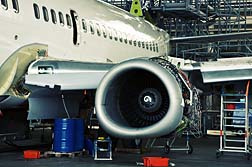 According to the Buffalo News, FAA flight inspector Christopher J. Monteleon complained a year ago about the poor performance of Colgan Air pilots during test flights on the Bombardier Dash 8 Q400. However, in an interview with the NTSB, Monteleon said that his warnings were ignored.
According to the Buffalo News, FAA flight inspector Christopher J. Monteleon complained a year ago about the poor performance of Colgan Air pilots during test flights on the Bombardier Dash 8 Q400. However, in an interview with the NTSB, Monteleon said that his warnings were ignored.Monteleon had been sent to Colgan Air to monitor the airline before it was given the approval to fly passengers on the Dash 8. He was with pilots in the cockpit during training flights. An NTSB report of Monteleon's interview noted, "The egregious safety violations he observed over the year were systemic. Pilots either did not know better or were subject to the culture at Colgan."
Among the violations that Monteleon allegedly observed were the pilot and first officers inappropriately switching seats; a candidate for upgrade to captain who had difficulty hand flying the aircraft, maintaining airspeed and recovering from stalls; a Colgan aircrew taking off despite patches on the de-ice boots that were not airworthy; passengers getting on and off the plane with engines still turning; pilots flying while fatigued; and frequent violations of "sterile cockpit" rules, which prohibit unnecessary talk during critical phases of a flight.
Those allegations are particularly damning because it has been alleged that an incorrect response to an airplane stall and violations of the "sterile cockpit" rules were factors in the Clarence Center crash that took 50 lives, 49 on the plane and 1 on the ground.
According to The New York Times, Monteleon also found that pilots flew the planes faster than specifications allowed, flew with a broken radio and tried and failed 3 times to approach the airport in Charleston, W. Va.
The FAA said that following Monteleon's complaints, an impartial team of inspectors was sent to Colgan Air but failed to find any major regulatory violations. Colgan Air says that it met or exceeded every FAA requirement necessary for including the Q400 in its fleet.
Monteleon alleges that following his complaints about the Colgan pilots, the FAA transferred him to a desk job in retaliation for his concerns about the airline.
"His [Monteleon's] view was that Colgan was absolutely deficient in its manual and its training of pilots, and as a result, sloppy practices took place that compromised the safety of passengers," Monteleon's attorney said in an interview with a Buffalo news program.
According the NTSB report, Monteleon was assigned to Colgan Air from July 23, 2007 to sometime in May 2008. He began working with the FAA in 1997.
Meanwhile, information has come out that the Air France jet that vanished over the Atlantic Ocean was due to have maintenance work done on its airspeed sensor system, according to a report in The New York Times. The system involves a component called a Pitot tube, which was the component Airbus, maker of the A330 aircraft, recommended replacing. Pitot tubes can ice in cold weather, which the plane may have encountered during its flight. The Pitot tube helps to measure a jet's air speed, which is vital to flying the aircraft. A plane that is moving too fast can break up in the air while a plane that moving to slowly can lose lift.
READ MORE PLANE CRASH LEGAL NEWS
In addition to speed sensor problems, one of the 24 messages showed the rudder was broken, making it impossible to control the jet, and the final message showed a drastic drop in air pressure in the cabin, which might indicate that the plane disintegrated in air. The autopilot was off at the time of the crash.
Investigators have said that weather at the time of the crash was normal for the area.
A spokesperson for Airbus said that recommendation to replace Pitot tubes was due to improve performance, not out of safety concerns. The recommendation was made in 2007. Air France Flight 447 was carrying 216 passengers and 12 crewmembers at the time of the crash.
